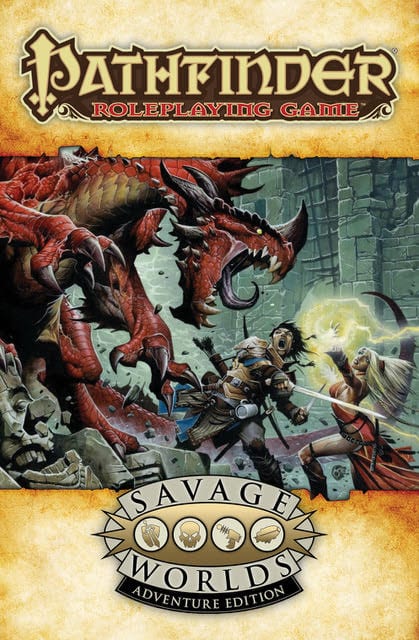
One of the bigger stories at the end of last year and the beginning of this year was that Pinnacle Entertainment Group received the blessing from Paizo to do official versions of Pathfinder Adventure Paths converted to run with the Savage Worlds rules. If you aren’t familiar, Savage Worlds is the official in-house system for Pinnacle and powers many of their titles such as Deadlands, Savage Rifts, and Rippers and bills itself as “Fast! Furious! Fun!” and my (admittedly limited) experience with the game shows that to be true.
Unlike a class based system that people familiar with Pathfinder are likely familiar with, character generation and advancement in Savage Worlds is fairly freeform with points being divvied up among a characters Traits and a number of broad Skills. Every roll you make is based on one of these Traits or Skills paired with what’s called the Wild Die and you’re looking for one of those two dice to beat the Target Number in order to succeed. Your character also has what are known as Edges, things that set you apart from someone else that has similar Traits and Skills. These are things like the ability to cast magic spells or advanced combat abilities that would fall into the realm of class abilities in a game like Pathfinder. As your character adventures, they gain Advancements which can be used to increase Traits and Skills or spent to purchase new Edges. As you earn more Advancements, you increase in Rank (Novice to Seasoned, Seasoned to Veteran, etc) and unlock the ability to purchase more powerful Edges.

Given that there’s already a major difference in how characters are generated and how the two systems handle advancement, I was interested to see how Savage Worlds Pathfinder would work, and at first brush I’m pretty impressed. Character generation is handled in the same free-form manner, but they have also taken the core classes and created what are known as “Class Edges” which provide a certain number of abilities and restrictions that are representative of the class – Barbarians have their powerful Rage ability but are restricted to wearing Medium armor or lighter or they suffer penalties. Spellcasting classes get access to unique Arcane Backgrounds that give them access to certain powers (the generic term Savage Worlds uses for things like magic spells or psionic abilities). Each Class Edge also gives the character access to more powerful abilities they can purchase as additional Edges like a Cleric’s ability to destroy undead or a Druid’s ability to wild shape. To encourage players to think of the “iconic characters” of the Pathfinder universe, characters are able to take a Class Edge for free at character creation (something that would have to purchased with resources in normal Savage Worlds play).
Also introduced are the concept of “Prestige Edges.” If you’re familiar with Pathfinder or its predecessor Dungeons and Dragons 3rd Edition, you’re familiar with the concept of prestige classes. Well, Prestige Edges are that concept for Savage Worlds, a tree of three increasingly more powerful Edges that follow a certain theme such as Assassin or Mystic Theurge and boasting certain prerequisites to be able to qualify for them.
These Class and Prestige Edges, coupled with more “traditional” Edges that Savage Worlds players are familiar with and the more freeform character advancement of the system means that you can create the character that you want to play in a way that may not have been possible in the more structured class and level system that Pathfinder holds itself to. So if you like the concepts of Pathfinder, but find that leveling structure to rigid this game is definitely worth checking out.
There’s a few other tweaks to this version of the Savage Worlds rules to make this game feel more heroic or more like Pathfinder – heroes can take an additional wound and several powers were tweaked or created whole cloth to better emulate some of the more classic spells present in the Pathfinder rules, but at it’s core it’s the Savage Worlds rules you know and love set in Golarion. The art assets all appear to be from Paizo including lots of art of the iconic characters from the Core Rulebook. Each of these 11 iconic characters is presented as a fully generated character as well complete with a full list of advancements if you’re looking to throw together a one-shot and want to use them or simply need inspiration for your own character. The book is laid out in such a way that it’s easy to read and follow. Anyone familiar with Pinnacle’s work will be able to see their quality in how the book is presented.
I for one am excited to take game out for a spin later with a buddy planning to run the Rise of the Runelords AP that was Kickstarted along with the Core Rulebook for Pathfinder Savage Worlds and put it through it’s paces. Now I just need to figure out what I want to play… and that’s the million gp question.
